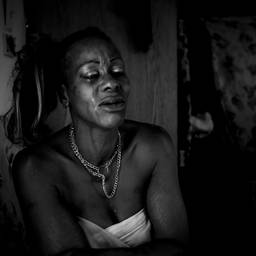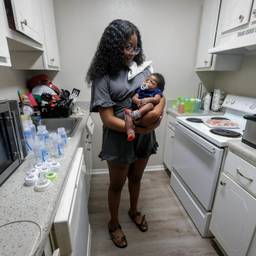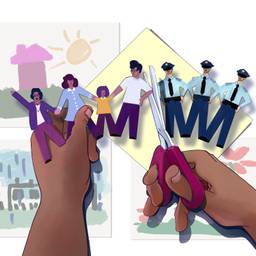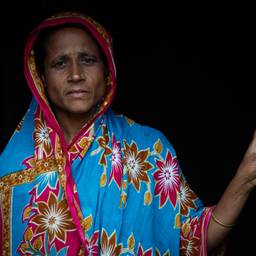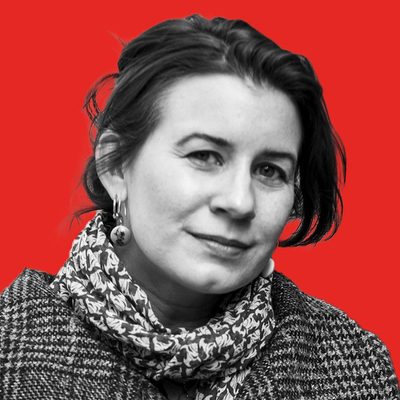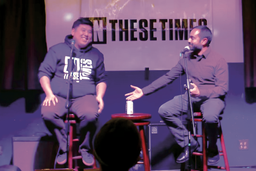Adoption Is Not a Solution to Broken Abortion Law
“An underlying factor for all of the adoptions in my study is that most mothers that I interviewed didn’t want to be relinquishing in the first place.”
Kathryn Joyce

In June 2022, U.S. Supreme Court Justice Samuel Alito suggested, in the majority opinion of Dobbs v. Jackson Women’s Health Organization, that one outcome of ending the constitutional right to abortion might be an increase in private domestic adoptions.
In a footnote to his opinion, Alito noted that, according to a 2008 CDC report, “nearly 1 million women were seeking to adopt children in 2002 (i.e., they were in demand for a child), whereas the domestic supply of infants relinquished at birth or within the first month of life and available to be adopted had become virtually nonexistent.”
A similar argument had been previewed several months earlier during oral arguments for the case. Then, Justice Amy Coney Barrett declared that the existence of adoption and “safe-haven” laws — a politically popular but rarely-used mechanism for parents to relinquish infants at places like fire stations — already protected women from “forced motherhood,” so abortion access wasn’t necessary. Barrett, an adoptive mother herself, declared that the choice pregnant women faced was not between abortion and compulsory parenthood, but rather “between, say, the ability to get an abortion at 23 weeks, or the state requiring the woman to go 15, 16 weeks more and then terminate parental rights at the conclusion.”
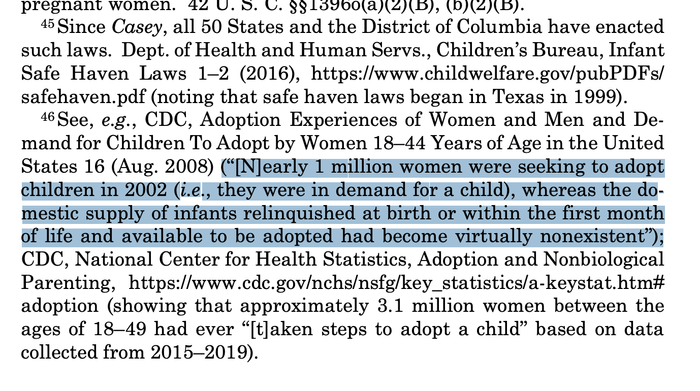
Alito’s and Barrett’s arguments were greeted with immediate outcry: that a far-right SCOTUS was paving the way to treat pregnant women as the source of a commercial product, a domestic supply of adoptable babies. But Alito was only saying the quiet part out loud. Because in truth, that’s long been the reality across much of the adoption industry. For all the rhetoric of “win-win-win” solutions that surround adoption — domestic and foreign, private and public — for decades, adoption has too often functioned as a supply-and-demand industry, where mostly poorer women provide the supply to meet richer families’ demand.
That conclusion is unavoidable in reading Gretchen Sisson’s new book Relinquished: The Politics of Adoption and the Privilege of American Motherhood. Sisson, a sociologist at the University of California, San Francisco and a researcher with the landmark Turnaway Study, which tracked outcomes for women denied abortions, undertook a 10-year study, from 2010 to 2020, of women who relinquished babies for adoption. She found that the overwhelmingly common factor to women choosing to relinquish children for adoption today is income disparity and poverty, and the overwhelming outcome for those women is enduring grief and loss.
Relinquished fills in an important gap in existing scholarly and journalistic work on adoption by bringing readers the most up-to-date assessment of what private U.S. infant adoption looks like today. And it could hardly arrive at a more pivotal moment for reproductive justice, as states enacting or expanding abortion bans also pass laws mandating public school instruction on why adoption is better than abortion, fund manipulative advertising campaigns casting adoption as an “empowering option” or propose federal databases to track pregnant women and direct them towards adoption agencies and the crisis pregnancy centers they work with.
I spoke with Sisson this spring about her book, the reality of relinquishment today and why adoption is an inherently conservative system.
This interview has been edited for length and clarity.
KATHRYN JOYCE: What made you first start paying attention to adoption?
GRETCHEN SISSON: I was doing a lot of work with young parents and saw the ways their stories and parenthood were really marginalized. So I was already looking at these recurring gaps between the way we talk about a phenomenon and the way people actually live it. That was true around abortion access and young parenthood. And it was increasingly apparent to me that it was true about narratives that presented adoption as a political solution for any number of things — lack of abortion access, inaccessibility of infertility treatments, our failure to support young families.
I didn’t come to the political understanding of adoption I have today until after I did my second round of data collection in 2020. In 2010, when I did my initial round of interviews, there were several mothers who were in a really optimistic, positive place about their adoptions. I’d seen a lot of people who adoption was failing as a system, but I thought maybe it’s possible to still have good scenarios.
It wasn’t until I did my follow-up data collection with those participants 10 years later that I came to a much more critical place — because they were in a much more critical place. Some reviews of my book say I used these specific stories in service of a greater agenda. But I didn’t cherry-pick these stories. This is the inevitable place the data brought me.
One thing that’s so valuable about your book is how current your cases are, covering women who relinquished children for adoption over the last 10 to 20 years. What is the modern experience of relinquishment compared to earlier eras, including the “Baby Scoop Era”?
The Baby Scoop Era, from the end of World War II until Roe v. Wade, was a period of deeply coercive, secretive, closed adoptions. Those were uniformly traumatic for the mothers who experienced them. Adoption does look very different today: they’re open, it’s framed as this really empowering choice, and there’s not the same degree of secrecy as there was 50 to 70 years ago.
When you look at Baby Scoop Era mothers, these were often young, middle-class, white women being driven to relinquish by their own parents. Adoption was a way for them to delay parenthood: “We’re going to have you relinquish this baby, then you’ll forget about this and go back to normal life, and then have children within the context of marriage, which is more appropriate.”
Today that’s no longer the case. Most birth mothers today already have children at home, so this isn’t a way of delaying parenthood. It’s a reflection of the lack of capacity: “We cannot afford another child” — or a child. And poverty seems to be the most common defining characteristic. Within my 10 years of data collection, we started to see a lot more women of color participating in the private adoption system. I think that’s because poverty has become this commonality that drives so much relinquishment.
Another question is: even if there’s not coercion, is there full autonomy? Is this a system you would be participating in if you had better control over your circumstances? An underlying factor for all of the adoptions in my study is that most mothers that I interviewed didn’t want to be relinquishing in the first place. They’d either wanted to have an abortion — that was the minority — or they really wanted to parent, but they got to a place where they felt that was untenable. Is that coercion? Probably not. But they’re interacting with a system that, if they had actual control over their circumstances, they wouldn’t be.

Then there’s manipulation: targeted advertising that is laser-focused on selling adoption to pregnant people as an “empowering” option. You’ll see that with a lot of virtual and physical geofencing, where pregnant people who go to reproductive health clinics, abortion clinics or public hospitals start getting a lot of ads for adoption agencies.
Then you have outright coercion: mothers who might have received housing or food support from adoption agencies or prospective adoptive parents during their pregnancy, who are told that they’ll need to pay them back or be charged with fraud if they decide to parent. Or who are told, “If you keep this baby, we’re going to call child protective services on you, because you’re not prepared to have this baby.”
So there is some very overt coercion that still happens. But most of it is a push toward adoption that also feeds this broader cultural narrative of adoption as a real force for social good. We don’t question the way adoption is marketed because we believe it’s a good practice. And that shapes a lot of where we allow the conversation to go.
There’s a distressing throughline in your book of how little money it would take to change many mothers’ lives. One mom said just $1,000 would have let her keep her baby. Can you talk about the role class plays in adoption?
Most relinquishing mothers have less than $5,000 of personal annual income. They may have support from other places, but they don’t have the power to do what they want with money they control. Not all adoptive parents are extraordinarily wealthy, but the median income for most adoptive families is around $100,000. That’s a pretty stark difference.
But more significant than numbers is the fact that we don’t believe people living in poverty are good parents. We don’t ascribe any value or meaning to anything they can offer their children that outweighs what a more affluent adoptive family could offer. So the things we value about parenthood are all tied to markers of social class: Your safe home, your nice neighborhood, your access to good public schools. Your backyard, your open outdoor space, your supportive family. And the profiles prospective adoptive parents develop are really keyed in to these things: that we are an aspirational home for a child because we can offer this middle class or above lifestyle.
So many of the mothers I interviewed were in such a place of struggle and vulnerability that they were starstruck by their child’s adoptive parents. One mother talked about how she was making $9/hour while her son’s adoptive mother was a fashion designer. So it’s not just the income disparity but also our broader ideas of who deserves to be a parent.
People push back on the idea that mothers only need a couple thousand dollars to avoid adoption. But it’s not about what they need to actually raise a child. It’s what they need to get through whatever crisis they’re facing. Maybe they just need enough for a security deposit on a new apartment or enough to buy a car seat, a crib and some diapers. Some just needed access to maternity leave because they couldn’t afford to take time off work. These gaps are so small and they still fell directly through them.
Of course, families in this position are going to need more social investment over time to raise their children successfully. But so many American families live in that space already. The way I usually phrase it is these mothers don’t need to get from A to Z, they just need to get from A to B. And once they’re at B, they’ll figure out how to get to C to D to E, like so many families already do.
What about the ways that class informs how adoption is represented in popular culture or media? How does the mainstream media’s “affluent bias” affect how we talk about adoption?
For people of a certain income level, the way you understand adoption is entirely about the families formed by adoption, with a lot of invisibility around the families separated by adoption. That becomes the driving understanding of what adoption looks like. One of my participants said, “My son’s adoptive family needs to understand that what they’re celebrating, their family, was made possible by my heartbreak, my loss.” And we don’t pay any attention to that.
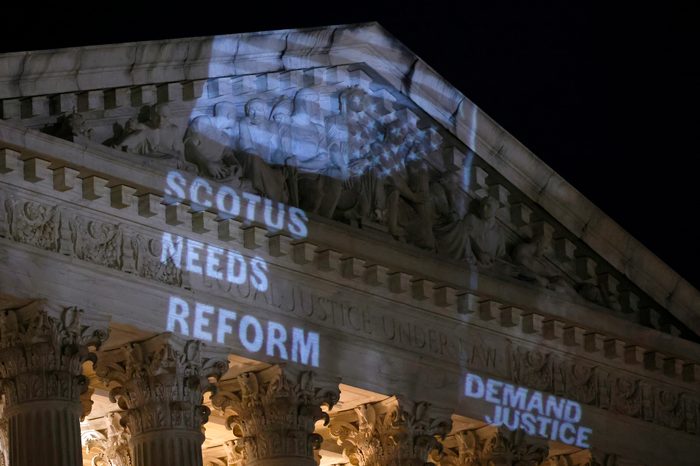
The biggest part of that is the idea that poor people are not worthy parents. That you should not be having children that you cannot afford entirely on your own. But because we don’t want to say poor children in the United States are suffering because we aren’t supporting their families, we’ll say this is because their mom was a teen mom, and put the blame on her. That this isn’t about our unwillingness to support poor parents, but about keeping children safe.
We have these recurring frames that allow us to deeply stigmatize anyone who attempts to parent in poverty while claiming we’re talking about something else.
You write about Camille, who was undergoing a severe postpartum mental health crisis and worried if she didn’t relinquish her baby, she would lose all her children to CPS. How is the private adoption system intertwined with the child welfare system?
The history of private adoption is overwhelmingly white. But that doesn’t mean families of color were protected from family separation. They just faced child removal and family separation through other systems — the family policing system or, historically, in the context of slavery, the Jim Crow South or the Indian Adoption Project and boarding schools. These things are all relevant histories to understanding how we value which families and who we believe has a right to their children. And what can be accomplished by separating them — either to meet a market demand, to police and enact social control or to enforce cultural assimilation.
Many of these systems work in tandem to create conditions that separate families, within both private and public systems. My research focuses on the private system, but because so much private adoption is increasingly shaped by poverty, these systems are becoming more and more closely entwined.
I included Camille’s story because I think it’s important that she knew she wasn’t a safe parent for her baby while she was facing postpartum psychosis. But there was no system she could avail herself of, or crisis care she trusted, that would allow her to keep custody of her older children. Her child’s father had passed away. She didn’t have a network to care for the baby while she got well. So she relinquished the baby for private adoption.
You also see this through mothers who lost older children to foster care and, when they’re pregnant again, are told, “You’re probably going to lose this baby to foster care, but if you choose a private adoption, then you can pick the parents and have an open adoption.” So there’s the idea that private adoption will give them more control over the situation. But it isn’t legally binding and it overlooks the fact that the stated intention of foster care in most cases is reunification — even if it rarely works that way — while private adoption offers no such path to regaining or retaining custody.
We’re seeing this threat of the family policing system as something that is pushing women — particularly women of color and very particularly Black women — to engage with the private adoption system in a way that we haven’t seen historically.
Let’s talk the role of adoption in the Dobbs decision. Why isn’t adoption the answer to abortion that the Supreme Court’s right-wing justices suggest it is?
Most of the mothers I interviewed wanted to parent. Some had wanted an abortion, and couldn’t get one or afford one. But most of them wanted to raise their child and that’s why they continued the pregnancy.
We know from the Turnaway Study that when people are denied access to abortion care you do have higher numbers of adoption relinquishment. But that’s still the minority. When you look at people who are denied access to the abortions they want, 9% of them relinquish for adoption, while more than 90% raise the child from a pregnancy that they were forced to continue. So when you have abortion bans, you’re always going to have far, far more people parenting in circumstances or timing they didn’t choose than people relinquishing for adoption.
People say, “We just need to educate them more about adoption.” No. People seeking abortions are not interested in adoption. There was one survey of abortion patients that asked if they were interested in adoption; 99% said “no,” 1% said “sort of,” 0% said “yes.” It’s not that they don’t know this is out there. This is not a practice they’re interested in.
All that being said, the numbers of people who need abortion care are so high, and the numbers of domestic adoption relinquishments are so low, that even that 9% is a pretty meaningful increase. So you will probably see an increase in adoptions over time as a result of Dobbs. But you’re going to have far, far more people who are either still getting abortions one way or another or parenting as a result of abortion denial.
You write at one point that adoption is an inherently conservative system. How so?
Adoption is conservative in that it allows us to uphold this really specific idea of what family is or should be. It’s typically this class narrative, this heteronormative narrative, this two-parent narrative, this racialized idea. It’s a very specific, normative understanding of family and the appropriate spaces for rearing children.
But it’s also conservative in that it’s a private solution to addressing a social need. Rather than providing a meaningful, robust, publicly-funded social safety net for families that allow for things like prenatal care, maternity leave, access to affordable housing, living wages, early childhood education — all these things we know make parenting possible for more people — rather than devoting resources to that, we introduce the private solution of adoption, in which a lot of money is exchanged.
At the same time, we put a lot of public money into the system of adoption itself. The federal tax benefit is more than $15,000 per adoption. We put a lot of state funding into crisis pregnancy centers that refer people to private adoption agencies. Texas just launched a multi-million-dollar marketing campaign targeted at Black and Latino communities, framing adoption as an empowering choice. Those are public resources going towards marketing and then subsidizing adoptions, let alone the philanthropic and private dollars that go into these organizations. If we put similar investment into a safety net that actually serves and keeps families together, these adoptions wouldn’t occur in the first place.
Concern about adoption as a reproductive justice issue seems to rise and fall in response to various moments — the Dobbs ruling, the family separation crisis, the missionaries trying to take children out of Haiti after the 2010 earthquake. But we don’t remember adoption is a justice issue in between these scandals. What would it take for us to more permanently recognize adoption as part of reproductive justice?
We’re doing it again. After the Russian invasion, people said, “We need to restore Ukrainian adoptions.” The response to what’s happening in Gaza is, “Can we adopt Palestinian children?” You see this narrative popping up like we haven’t learned that lesson.
The moments you’re talking about have been jarring because they made the political center-left reconcile its preconceived notions of adoption. When family separation was happening at the border as this Trumpian policy, and children were being given over to the custody of private adoption agencies, that was jarring to people. Something similar happened with Dobbs. They were these reminders that adoption is a market-based system and has these conservative ideologies at its root.
That’s important because the ways adoption has been framed as a social good are not inherently recognized as conservative. Instead, we use language — like “chosen family” or “Love is what makes a family” — that aligns adoption as a progressive value without looking at what family separation actually means and the conservative roots of family separation. It takes these moments for people to reconsider what adoption looks like from that perspective.
As to the broader question of how you tie this into the reproductive justice movement, family preservation has always been part of the theoretical framework for reproductive justice. But because of the really white history of private adoption, and because of the roots of the reproductive justice movement in Black women’s organizing, those connections — between private adoption and the family policing system — haven’t been made as readily in terms of collaboration and movement building.
We’re starting to get there. A lot of organizing within the reproductive justice movement around adoption has come from BIPOC adoptees. That’s really crucial to this next phase of how we reconcile what adoption means for our culture and how we understand who it serves, and how we fit that within our broader understanding of organizing.
KATHRYN JOYCE is investigative editor at In These Times and author of The Child Catchers: Rescue, Trafficking and the New Gospel of Adoption and Quiverfull: Inside the Christian Patriarchy Movement.
